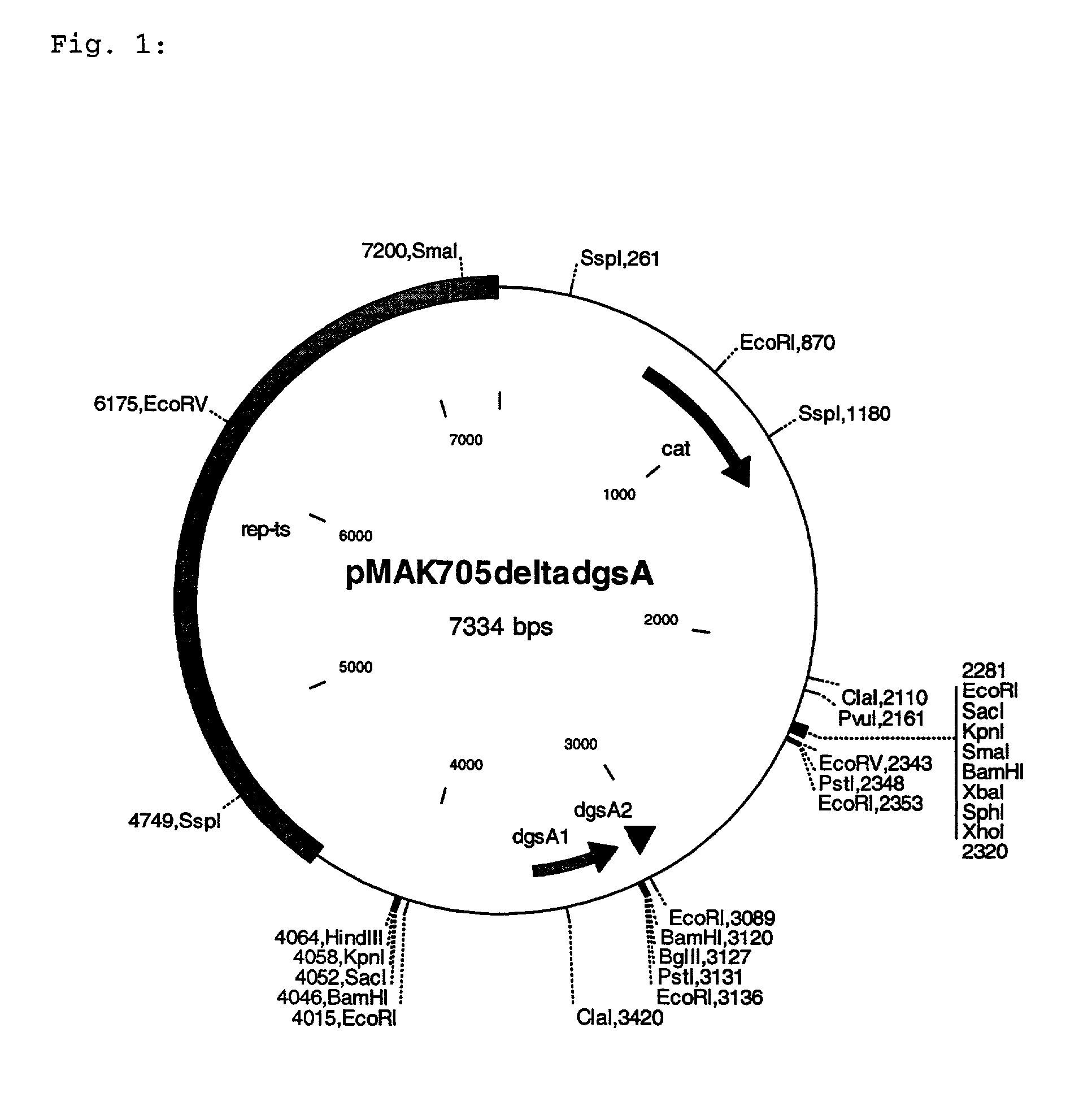Process for the production of L-amino acids using strains of the family enterobacteriaceae that contain an attenuated dgsA gene
a technology of enterobacteriaceae and dgsa gene, which is applied in the field of process for the production of lamino acids using strains of the family enterobacteriaceae, can solve the problems of incomplete disruption of enzyme activity, false incorporation of amino acids or premature termination of translation, and premature termination of translation
- Summary
- Abstract
- Description
- Claims
- Application Information
AI Technical Summary
Problems solved by technology
Method used
Image
Examples
example 1
Construction of the Deletion Mutation of the dgsA Gene
[0110] Parts of the gene regions lying upstream and downstream of the dgsA gene and parts of the 5'-region and 3'-region of the dgsA gene are amplified from Escherichia coli K12 using the polymerase chain reaction (PCR) as well as synthetic oligonucleotides. Starting from the nucleotide sequence of the dgsA gene and sequences in E. coli K12 MG1655 (SEQ ID No. 1, Accession Number AE000255) lying upstream and downstream, the following PCR primers are synthesised (MWG Biotech, Ebersberg, Germany):
1 dgsA'5'-1: 5'-CGAATGTAACGCTGGCTGAA-3' (SEQ ID No.3) dgsA'5'-2: 5'-TCCAGCAATGGCAAGTCATC-3' (SEQ ID No.4) dgsA'3'-1: 5'-CAGCACATCAGCGTTGAGAG-3' (SEQ ID No.5) dgsA'3'-2: 5'-GATCGCCTGAGCTGTTAGCA-3' (SEQ ID No.6)
[0111] The chromosomal E. coli K12 MG1655 DNA used for the PCR is isolated according to the manufacturer's instructions using "Qiagen Genomic-tips 100 / G" (QIAGEN, Hilden, Germany). A ca. 850 bp large DNA fragment from the 5'-region of ...
example 2
Construction of the Exchange Vector pMAK705.DELTA.dgsA
[0113] The dgsA allele described in Example 1 is isolated from the vector pCR2.1TOPO.alpha.dgsA after restriction with the enzymes HindIII and XbaI and separation in 0.8% agarose gel, and is ligated with the plasmid pMAK705 (Hamilton et al. (1989) Journal of Bacteriology 171, 4617-4622), that had been digested with the enzymes HindIII and XbaI. The ligation batch is transformed in DH5a and plasmid-carrying cells are selected on LB agar to which 20 .mu.g / ml of chloramphenicol have been added. The successful cloning is detected after plasmid DNA isolation and cleavage with the enzymes HindIII and XbaI. The resultant exchange vector pMAK705.DELTA.dgsA (=pMAK705deltadgsA) is shown in FIG. 1.
example 3
Site-specific Mutagenesis of the dgsA Gene in the E. coli Strain MG442
[0114] The E. coli strain MG442 producing L-threonine is described in patent specification U.S. Pat. No. 4,278,765 and is filed as CMIM B-1628 at the Russian National Collection for Industrial Microorganisms (VKPM, Moscow, Russia).
[0115] For the exchange of the chromosomal dgsA gene by the plasmid-coded deletion construct, MG442 is transformed with the plasmid pMAK705.DELTA.dgsA. The gene exchange is carried out by the selection process described by Hamilton et al. (1989) Journal of Bacteriology 171, 4617-4622) and is verified by standard PCR methods (Innis et al. (1990) PCR Protocols. A guide to methods and applications, Academic Press) with the following oligonucleotide primers:
2 dgsA'5'-1: 5'-CGAATGTAACGCTGGCTGAA-3' (SEQ ID No.3) dgsA'3'-2: 5'-GATCGCCTGAGCTGTTAGCA-3' (SEQ ID No.6)
[0116] After the exchange the form of the .DELTA.dgsA allele shown in SEQ ID No. 8 is present in MG442. The strain obtained is design...
PUM
| Property | Measurement | Unit |
|---|---|---|
| Electrical resistance | aaaaa | aaaaa |
| Catalyst | aaaaa | aaaaa |
Abstract
Description
Claims
Application Information
 Login to View More
Login to View More - R&D
- Intellectual Property
- Life Sciences
- Materials
- Tech Scout
- Unparalleled Data Quality
- Higher Quality Content
- 60% Fewer Hallucinations
Browse by: Latest US Patents, China's latest patents, Technical Efficacy Thesaurus, Application Domain, Technology Topic, Popular Technical Reports.
© 2025 PatSnap. All rights reserved.Legal|Privacy policy|Modern Slavery Act Transparency Statement|Sitemap|About US| Contact US: help@patsnap.com

